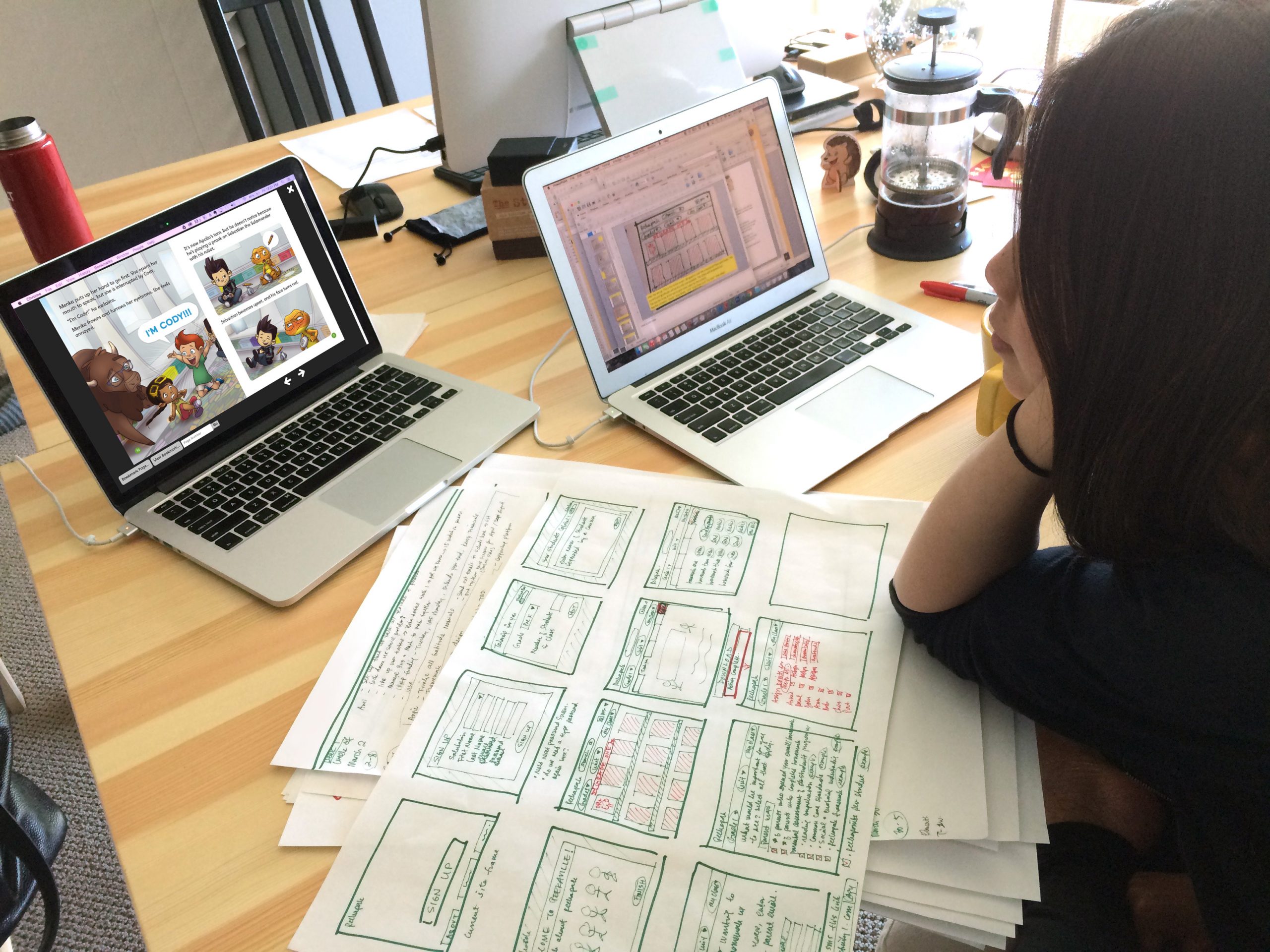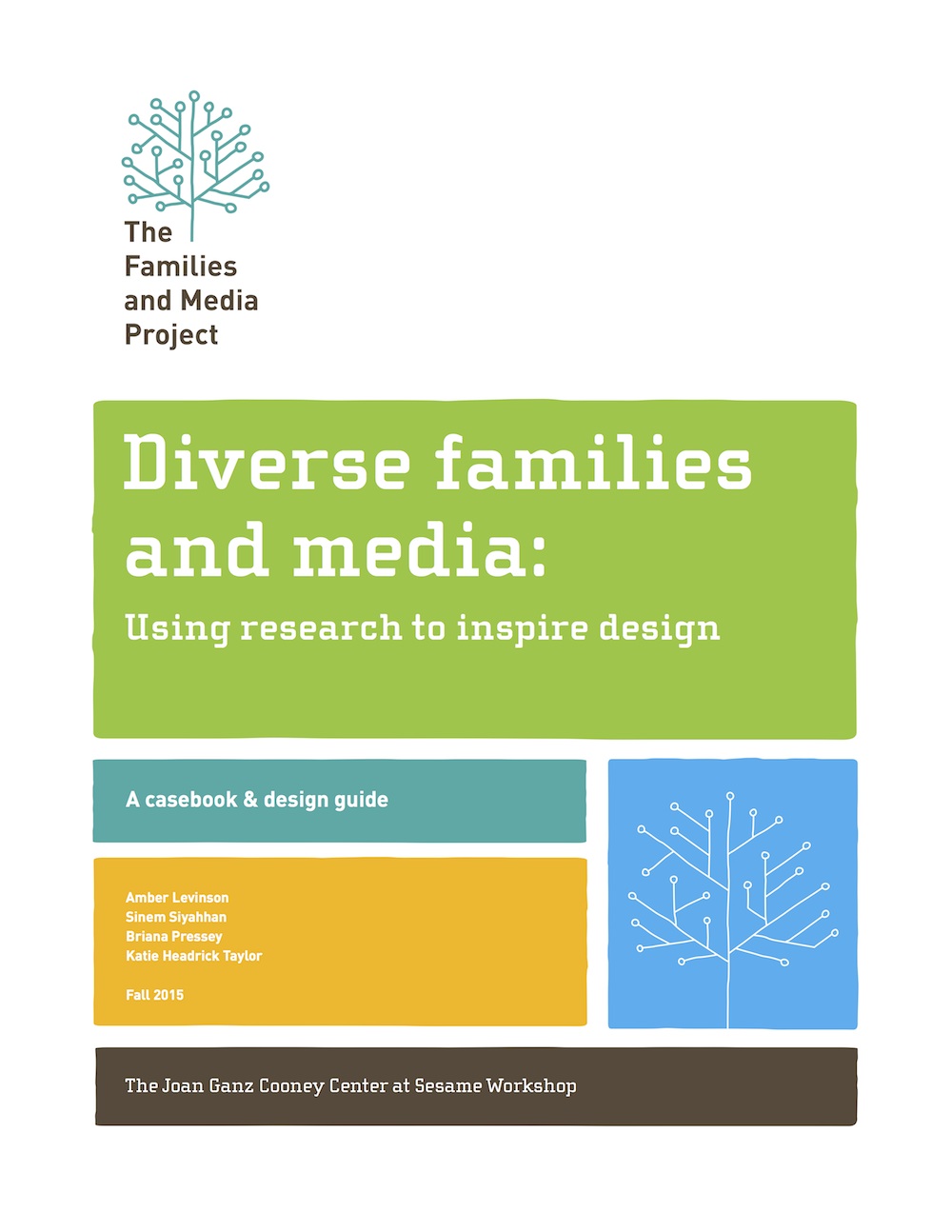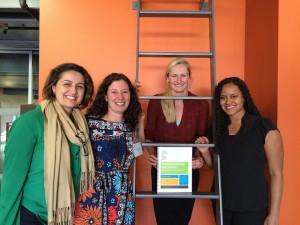
Photo by Lori Takeuchi
Last week we released Diverse Families and Media: Using Research to Inspire Design, at the Stanford Graduate School of Education and Hasso Plattner Institute of Design (d.school). The report draws from research conducted by the Families and Media consortium around media use in predominantly Latino families living in New York/New Jersey, the San Francisco Bay Area, Phoenix, and Chicago. This casebook and design guide aims to provide insight on family media use, prompts for thoughtful discussion, and inspiration for the design of products and programs for children and families. The launch event was a joint effort between the Joan Ganz Cooney Center, Stanford’s brand new TELOS (Technology for Equity in Learning Opportunities) initiative, and Digital Promise.
About 100 researchers, designers, practitioners, and media producers were invited to the Center for Education Research at Stanford for two panels, including representatives from organizations such as Peekapak, Redwood City School District, EdSurge, PBS Kids, and Khan Academy. Brigid Barron, a professor at the Stanford Graduate School of Education and one of the Families and Media Project’s principal investigators, welcomed participants with a short talk on designing high quality content at the intersection of technology, equity, and learning.
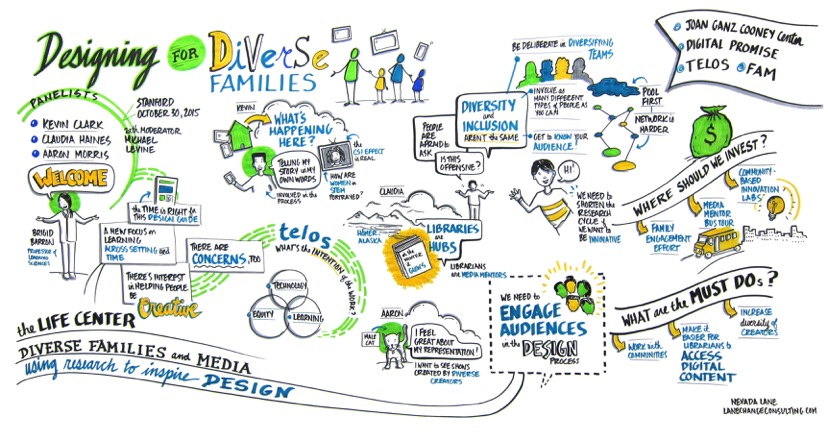
Image: Nevada Lane
The first panel, “Designing for Diverse Families,” was moderated by the Cooney Center’s Michael Levine and featured Kevin Clark (George Mason University), Claudia Haines (Association for Library Service to Children), and Aaron Morris (PBS KIDS Digital). One main takeaway of this panel was a call for more diversity among the creators of content as well as involving the target audiences as the content is created. Kevin Clark and Aaron Morris especially emphasized the importance of diverse creators of media to help shape conversations around designingcontent. Involving the users early on in the design process is also of utmost importance, as they can provide unique and personal perspectives to mold the design process in more effective and relatable ways. Claudia Haines also highlighted the significance of libraries as sites for media mentorship and as hubs of opportunities for early literacy. The panelists closed with suggestions for investments, which included a media mentor national bus tour, more family engagement efforts, and community-based innovation labs.
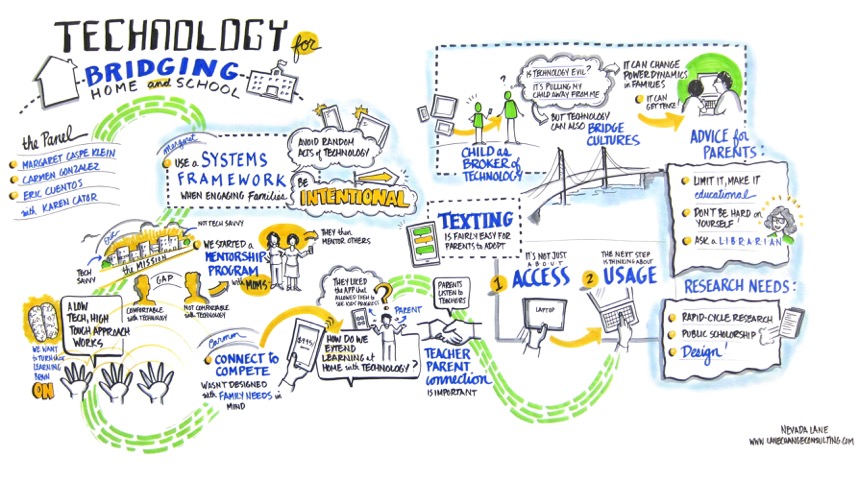
Image: Nevada Lane
The second panel, “Opportunities to Support Home-School Connections Using Technology,” was moderated by Karen Cator of Digital Promise and featured panelists Carmen Gonzalez (University of Washington), Eric Cuentos (Mission Graduates), and Margaret Caspe Klein (Harvard Family Research Project). The panelists stressed the importance of considering the diversity within Latino families (i.e., country of origin, socioeconomic status, language) in design, and also gave some insights on different uses of media in Latino families. For instance, Carmen Gonzalez outlined the work that she and colleague Vikki Katz (Rutgers University) conducted with Mexican-origin families as part of the Families and Media Project. In their studies in Chula Vista, CA, Sunnyside, AZ, and Denver, CO, they found that children often act as “brokers” for their immigrant parents, performing tasks such as translating documents, and sometimes using digital media to do so. Margaret Caspe Klein also insisted that equity does not lie only in access to technology, but in families having the skills and knowledge to implement that technology into their homes and lives in meaningful ways. Eric Cuentos believes that the takeaway for designers should be to create low-tech, high-touch products for families.

Image: Nevada Lane
After the panels, about 50 participants were invited to move to the Hasso Plattner Institute of Design for a design workshop utilizing the Diverse Families and Media casebook. Amber Levinson was very systematic in creating working groups prior to the workshop, ensuring that each team allowed for opportunities to gain perspectives across research, industry, and practice. One sample group might contain practitioners from LitLab or San Francisco United School District, researchers from Stanford or Harvard, and industry leaders from Myon or Tales2Go. Each team also had a design coach to lead them through the design-thinking process, which was new to several participants.
The d.school design process usually consists of five steps: empathize, define, ideate, prototype, test. However, for the purposes of the design guide and workshop, the authors simplified this process to empathize, imagine, and create. Workshop teams were assigned to one of two cases: “designing for family language learning,” or “designing for the whole family by connecting to heritage culture.” For the empathy phase, team members read carefully through each case, pulling out facts about the families, their interests, values, and activities. Next, teams moved into the imagine phase, using “how might we” as a prompt to address the families’ possible needs. For example, “How might we use Jessica’s interest in science experiments as a tool for language learning?” From the “how might we” statements, participants had twenty minutes to create a prototype of a tool to address a possible family need.
Though the time allotted for the prototype phase was very short, participants seemed excited to pull their ideas together quickly, using improvisation, cardboard, paper, foil, and anything else they could find around the room. Finally teams were given the chance to present their programs and products based on their cases. Two teams designed programs to be implemented in libraries. The first was a six week dual-language, library-based program in which family members create a digital story of their family and their heritage, receiving instruction and digital literacy training along the way. The second group came up with a similar idea in which families create print and digital books about their family history and heritage, but leave the dual-language books in a designated physical space at the library for other families to read. This designated section has a trained media mentor as well as curated parent resources. A third group designed a fun dual-language unboxing family challenge, which they acted out for the rest of the participants. A family using this product would receive a package in the mail with particular instructions in both English and Spanish. For example, “Your challenge is to cook a family recipe.” The challenge also pinpoints roles that family members can choose from, such as chef, videographer, English recipe writer, and Spanish recipe writer. This allows each family member to feel like they have an important role in the process.
To debrief, Amber Levinson and Maryanna Rogers asked participants what they liked and learned from the event. Several participants said they greatly enjoyed the design process, and hoped to find ways to bring design thinking back to the work that they do at their own organizations. Others liked the cross-sector nature of their work groups, which offered diverse perspectives when interpreting the cases and coming up with designs. A sentiment that many seemed to have was the desire to stay in contact with one another, and continue the conversations that emerged throughout the day.
Similar to the debrief from the “Designing Media for Underserved Families” event last January, participants also expressed the value of ethnographic research and its potential to prompt thoughtful designs for underserved and diverse families. In interviews with media producers and designers to prepare Diverse Families and Media, some expressed the difficulty to consider how to design for anyone other than their “mainstream” target audience, due to time, budget, and a lack of knowledge. We hope that this casebook and design guide, based on ethnographic research, can serve as a step toward providing designers, producers, and practitioners with the inspiration and information they need to begin to meaningfully design with consideration for a diverse array of families.
Now, it’s your turn! Please download the report and use it as a basis for discussion, to inspire design with your team, or for personal reflection on your work.
Highlights from the Diverse Families and Media event at Stanford Graduate School of Education:
New publication: Diverse Families and Media: Using Research to Inspire Design https://t.co/l6E80G0n4B #FAMdesign pic.twitter.com/m4ufTpQj5k
— Cooney Center (@CooneyCenter) October 30, 2015
Kicking off the release of the Families and Media Project’s newest report, Diverse Families and Media at Stanford GSE #FAMDesign
— Cooney Center (@CooneyCenter) October 30, 2015
.@CooneyCenter event starting on Diverse Families & Media w @mlevine_jgcc leading the panel. #FAMDesign #research pic.twitter.com/zyEFVnueTt
— Scott Traylor (@360KID) October 30, 2015
Stating the day with the “Designing for Diverse Families” panel with @aaronleemorris @KevinClarkPhD @claudiahaines #FAMDesign
— Cooney Center (@CooneyCenter) October 30, 2015
When thinking about families & diversity, make sure to get those families involved in all aspects of the process @KevinClarkPhD #FAMDesign
— Cooney Center (@CooneyCenter) October 30, 2015
@claudiahaines: In Homer, Alaska, public libraries are a hub for media mentorship and literacy #FamDesign
— Cooney Center (@CooneyCenter) October 30, 2015
Part of what we need is more diverse people making television shows, products, etc. –@aaronleemorris of @PBSKIDS #FAMDesign
— Cooney Center (@CooneyCenter) October 30, 2015
Panelists at the Diverse Families and Media event at @StanfordEd pic.twitter.com/Ckq6vBahpT
— Jason Yip (@jasoncyip) October 30, 2015
How might we ensure enriching content is designed and made available for all? #FAMDesign @SesameWorkshop @reachfund pic.twitter.com/7eMLImu4X0
— Shauntel Poulson (@SLP_EDU) October 30, 2015
Media Mentorship in Libraries Serving Youth: https://t.co/UoAqj3p9ML via @claudiahaines #FAMdesign
— Angela Estrella (@am_estrella) October 30, 2015
RT @Bri_Pressey: If you don’t know the stereotypes and landmines to avoid, then you’re likely to step on them. @KevinClarkPhD #FamDesign
— Cooney Center (@CooneyCenter) October 30, 2015
Libraries are community shared spaces where everyone is welcome and can get access to free resources #equity @claudiahaines #FamDesign
— Cooney Center (@CooneyCenter) October 30, 2015
Create community innovation centers where families can create programs applicable to their own communities @KevinClarkPhD #FamDesign
— Cooney Center (@CooneyCenter) October 30, 2015
RT @Bri_Pressey: In design, try to have diverse teams. Who is creating the programs? @KevinClarkPhD #FamDesign
— Cooney Center (@CooneyCenter) October 30, 2015
Kicking off panel on home-school connections w/ panelists @mcaspeklein Eric Cuentos, & Carmen Gonzalez. Moderated by @kcator #FAMDesign
— Cooney Center (@CooneyCenter) October 30, 2015
.@CooneyCenter next panel on Diverse Families & Media lead by @KCator. #FAMDesign #research pic.twitter.com/XxBdhrHDKU
— Scott Traylor (@360KID) October 30, 2015
@CooneyCenter So excited to release the Cooney Center’s new report today @Stanford @DigitalPromise pic.twitter.com/Gr0PihYWtM
— Michael H. Levine (@mlevine_jgcc) October 30, 2015
Tech initiatives are not as effective when they are designed and rolled out w/o thinking about the needs of families #edtech #FAMdesign
— Aubrey Francisco (@aubreyfrancisco) October 30, 2015
What do families do with new access to technology? How do we extend the learning from school into the home? -Carmen Gonzalez #FAMDesign
— Cooney Center (@CooneyCenter) October 30, 2015
When recs for apps come directly from teachers, parents are more likely to use those apps or resources with their children #FAMdesign #tech
— Aubrey Francisco (@aubreyfrancisco) October 30, 2015
Need low tech high touch programs to engage families who are not as comfortable using tech tools. It’s about relationship bldg. #FAMdesign
— Aubrey Francisco (@aubreyfrancisco) October 30, 2015
Chula Vista School District app to bridge language acquisition and tech literacy. https://t.co/esrN1j58wj @sfusdedtech #FamDesign
— SFUSD MPD (@sfusdmpd) October 30, 2015
Create all of the home-school apps you want, but it’s all about relationships, mentorship, and promoting confidence -Eric Cuentos #FAMDesign
— Cooney Center (@CooneyCenter) October 30, 2015
How children bridge parent confidence and expertise with digital media @CooneyCenter @jasoncyip and Carmen Gonzalez.
— Katie HeadrickTaylor (@KayteeTaylor) October 30, 2015
It’s not just about access to tech. It’s about families having the skills and knowledge to meaningfully use it. @mcaspeklein #FAMDesign
— Cooney Center (@CooneyCenter) October 30, 2015
Librarians are playing a huge tech mentorship role, particularly for immigrant families. #FAMdesign #learning #edtech
— Aubrey Francisco (@aubreyfrancisco) October 30, 2015
Brigid Barron, @mlevine_jgcc, and Diverse Families and Media report 1st author Amber Levinson #FAMDesign pic.twitter.com/Nz3JenbLKS
— Cooney Center (@CooneyCenter) October 30, 2015
@kcator @DigitalPromise thinking about lifelong and life wide learning with technology @CooneyCenter event
— Katie HeadrickTaylor (@KayteeTaylor) October 30, 2015
@kcator @DigitalPromise thinking about research methods that address and report on innovation when peer review takes so long @CooneyCenter
— Katie HeadrickTaylor (@KayteeTaylor) October 30, 2015
Excited to coach! #famdesign
— ariel raz (@arielefant) October 30, 2015
#FAMdesign – can’t wait to innovate! pic.twitter.com/8oqeQIcYyK
— GlobalFamilyResProj (@GlobalFRP) October 30, 2015
You can say that again @aubreyfrancisco! Such impt educators and encouragers! #FAMdesign #STEM #STEAM #diversity https://t.co/DdHUObXPGC
— Roxann Stafford (@jroxann) October 30, 2015
Any ideas? Help us imagine, empathize and create! #famdesign pic.twitter.com/D3CquSUPRK
— GlobalFamilyResProj (@GlobalFRP) October 30, 2015
Everyone is linked up with their teams and ready to empathize, imagine, and create with the guide! #FAMdesign pic.twitter.com/aDIvcYmqGA
— Cooney Center (@CooneyCenter) October 30, 2015
Team getting into design challenge: designing for family language learning #FAMDesign pic.twitter.com/Z8E4BDlP5i
— Cooney Center (@CooneyCenter) October 30, 2015
Observations, needs, and insights to lead to solution brainstorming #FAMDesign pic.twitter.com/VXYrsjkOB0
— Cooney Center (@CooneyCenter) October 30, 2015
Awesome ideating with @arielefant #famdesign pic.twitter.com/Oy1LxnfA0j
— GlobalFamilyResProj (@GlobalFRP) October 30, 2015
Presenting prototypes! The teams have come up with some great ideas. #FAMDesign pic.twitter.com/Yb3KnRd7yB
— Cooney Center (@CooneyCenter) October 30, 2015
#FAMdesign panel on tech bridging home & school with Carmen Gonzalez, @mcaspeklein & Eric Cuentos #edtech pic.twitter.com/jrIHDSyr8J
— Angela Estrella (@am_estrella) October 30, 2015
Debrief on today’s events and discussions: “I’ve learned how powerful ethnographic research can be.” pic.twitter.com/ShVwVFpkDw
— Cooney Center (@CooneyCenter) October 30, 2015
Designing for Diverse Families #FAMdesign #edtech pic.twitter.com/PDxRjsn43u
— Angela Estrella (@am_estrella) October 30, 2015
Download Diverse Families and Media: Using Research to Inspire Design

